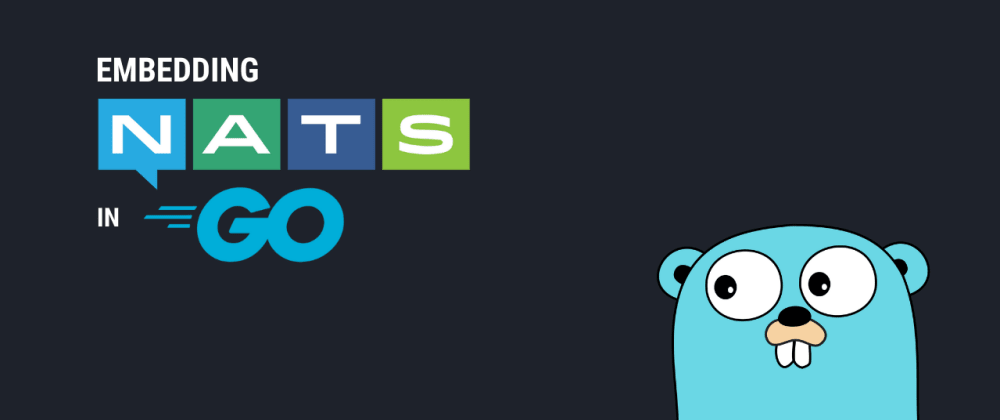- Published on
Embedding NATS in Go
6 min read
- Authors
- Name
- NMILI Abdelali
- @yonkoGo

Table of Contents
In this article, we will look at how we can embed NATS server within our Go application. After that, we will also do a little performance benchmark between embedded and external service.
Note: As always, all the code will be available here
Why do we need this?

While running nats server using cli or docker container is usually the preferred way but in some instances, it can be unnecessary, one such example is testing. While testing, it's often cumbersome to spin up new instances for external services, this can be completely avoided by using an in-memory server. Luckily, NATS server package provides this functionality out of the box!
Setup
Before writing any code, let's quickly set up our go project.
Go module
$ go mod init example
$ touch main.go
Dependencies
$ go get -d github.com/nats-io/nats-server/v2
$ go get github.com/nats-io/nats.go
Code
After the setup, we can now start by initializing a new server with options
opts := &server.Options{}
ns, err := server.NewServer(opts)
if err != nil {
panic(err)
}
Note: You can configure things like Host, Port, Authorization, and much more using server.Options.
Next, we will start the server via goroutine and wait for the server to be ready for connections
go ns.Start()
if !ns.ReadyForConnections(4 * time.Second) {
panic("not ready for connection")
}
Once our server is ready, we can connect to it with nats.go client using ClientURL function given by the server.
nc, err := nats.Connect(ns.ClientURL())
if err != nil {
panic(err)
}
Let's subscribe to a subject, and print message data. Optionally, we can call Shutdown function to stop the nats server.
subject := "my-subject"
nc.Subscribe(subject, func(msg *nats.Msg) {
data := string(msg.Data)
fmt.Println(data)
ns.Shutdown()
})
Finally, we will publish the data to our subject and call WaitForShutdown to keep our server running until shutdown.
nc.Publish(subject, []byte("Hello embedded NATS!"))
ns.WaitForShutdown()
Our complete example should look like this!
package main
import (
"fmt"
"time"
"github.com/nats-io/nats-server/v2/server"
"github.com/nats-io/nats.go"
)
func main() {
opts := &server.Options{}
// Initialize new server with options
ns, err := server.NewServer(opts)
if err != nil {
panic(err)
}
// Start the server via goroutine
go ns.Start()
// Wait for server to be ready for connections
if !ns.ReadyForConnections(4 * time.Second) {
panic("not ready for connection")
}
// Connect to server
nc, err := nats.Connect(ns.ClientURL())
if err != nil {
panic(err)
}
subject := "my-subject"
// Subscribe to the subject
nc.Subscribe(subject, func(msg *nats.Msg) {
// Print message data
data := string(msg.Data)
fmt.Println(data)
// Shutdown the server (optional)
ns.Shutdown()
})
// Publish data to the subject
nc.Publish(subject, []byte("Hello embedded NATS!"))
// Wait for server shutdown
ns.WaitForShutdown()
}
Build and Run!
Let's build and run our example binary with an embedded NATS server.
$ go build
$ ./example
Hello embedded NATS!
As we can see, we get the output from our subscriber!
Performance
Performance is an important aspect of every application, so let's compare the performance for using NATS as an embedded or external service (cli, docker etc). We will run a benchmark for 1 million messages for 8 intervals.
Setup
First, we'll need to start the external nats server
$ nats-server
[5868] 2022/02/22 20:09:21.073386 [INF] Starting nats-server
[5868] 2022/02/22 20:09:21.073657 [INF] Version: 2.7.0
[5868] 2022/02/22 20:09:21.073660 [INF] Git: [not set]
[5868] 2022/02/22 20:09:21.073662 [INF] Name: NCFHZUA6H6YRJHE65OXRW5X5NL2XDTR7Q4NBZG5Q2KEHZTFN6JMUK4HU
[5868] 2022/02/22 20:09:21.073665 [INF] ID: NCFHZUA6H6YRJHE65OXRW5X5NL2XDTR7Q4NBZG5Q2KEHZTFN6JMUK4HU
[5868] 2022/02/22 20:09:21.076236 [INF] Listening for client connections on 0.0.0.0:4222
[5868] 2022/02/22 20:09:21.076659 [INF] Server is ready
Results
Benchmark code can be found here, and can be run as below.
$ go run benchmark/benchmark.go
Results have been saved to results.html
Seems like there is not much difference in performance, that's really impressive considering we are testing for millions of messages.

Conclusion
In this article, we learned how we can embed nats server in our go applications. And also did a small performance benchmark. Make sure to checkout the official docs.